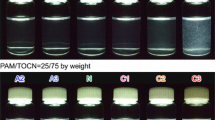Abstract
The elasticity of the polyacrylamide (PAAm)-kappa carrageenan (κC) composite was determined as a function of (w/v-%) κC content at 40 °C. The gel composites studied contained various percentages (w/v-%) of κC. The elasticity of the swollen PAAm-κC composite was characterized by using the tensile testing technique. This study investigated the elasticity and the percolation threshold of PAAm-κC composite as a function of κC content. It is understood that the compressive elastic modulus decreases up to 1 (w/v-%) of κC and then increases at contents above 1(w/v-%) of κC. The critical exponent of elasticity y was determined between 1 and 1.6 (w/v-%) of κC and found to be 0.68. The observed elastic percolation threshold is consistent with the suggested values of the superelastic percolation network.





Similar content being viewed by others
References
Aktaş DK, Evingür GA, Pekcan Ö (2006) Universal behaviour of gel formation from acrylamide-carrageenan mixture around the gel point: a fluorescence study. J Biomol Struct Dyn 24(1):83–90
Anseth KS, Bowman CN, Peppas LB (1996) Mechanical properties of hydrogels and their experimental determination. Biomaterials 17:1647–1657
Arbabi S, Sahimi M (1993) Mechanics of disordered solids. I. percolation on elastic networks with central forces. Phys Rev B 47(2):695–702
Berkowitz B, Balberg I (1993) Percolation theory and its application to groundwater hydrology. Water Res 29(4):775–794
Çakır E, Foegeding EA (2011) Combining protein micro protein micro phase separation and protein-polysaccharide segregative phase separation to produce gel structures. Food Hydrocoll 25:1538–1546
Colby RH, Gillmor JR, Rubinstein M (1993) Dynamics of near critical polymer gels. Phys Rev E 48(5):3712–3716
de Gennes PG (1976) On the relation between percolation theory and the elasticity of gels. Le J de Phys Lett 37:L1–L2
Erman B, Flory PJ (1986) Critical phenomena and transitions in swollen polymer networks and in linear macromolecules. Macromol 19:2342–2353
Evingür GA, Pekcan Ö (2011) Drying of polyacrylamide composite gels formed with various kappa carrageenan content. J Fluo 21:1531–1537
Evingür GA, Pekcan Ö (2012a) Elastic percolation of swollen polyacrylamide (PAAm)-multiwall carbon nanotubes (MWNTs) composite. Ph Transitions 85:553–564
Evingür GA, Pekcan Ö (2012b) Temperature effect on the swelling of PAAm–kcarrageenan composites. J Appl Polym Sci 123:1746–1754
Feng S, Sen PN (1984) Percolation on elastic networks: new exponent and threshold. Phys Rev Lett 52(3):216–219
Friedrich K, Fakirov S, Zhang Z (2005) Polymer composites from nano to macro scale. Springer, USA
Kantor Y, Webman I (1984) Elastic properties of random percolating systems. Phys Rev Lett 52(21):1891–1894
Loret C, Ribelles P, Lundin L (2009) Mechanical properties of k-carrageenan in high concentration of sugar solutions. Food Hydrocoll 23:823–832
Muniz EC, Geuskens G (2001) Compressive elastic modulus of polyacrylamide hydrogels and semi-IPN’s with poly (N-isoproplacrylamide). Macromolecules 34:4480–4484
Nielsen LE, Lawrence RF (1994) Mechanical properties of polymers and composites. Marcel Dekker, New York
Rubinstein RH, Colby H (1994) Elastic modulus and equilibrium swelling of near critical gels. Macromolecules 27:3184–3190
Sahimi M (1994) Application of percolation theory. Taylor and Francis, London
Schriemer HP, Pachet NG, Page JH (1996) Ultrasonic investigation of the vibrational modes of a sintered glass-bead percolation system. Waves Random Media 6:361–386
Spagnol C, Rodrigues FHA, Pereira AGB, Fajardo AR, Rubira AF, Muniz EC (2012a) Superabsorbent hydrogel composite made of cellulose nanofibrils and chitosan-graft-poly (acrylic acid). Carbohydr Polym 87(3):2038–2045
Spagnol C, Rodrigues FHA, Pereira AGB, Fajardo AR, Rubira AF, Muniz EC (2012b) Superabsorbent hydrogel nanocomposites based on starch-g-poly(sodium acrylate) matrix filled with cellulose nanowhiskers. Cellulose 19(4):1225–1237
Acknowledgments
We thank Dr. Argun Talat Gökçeören for the mechanical measurements.
Author information
Authors and Affiliations
Corresponding author
Rights and permissions
About this article
Cite this article
Evingür, G.A., Pekcan, Ö. Superelastic percolation network of polyacrylamide (PAAm)–kappa carrageenan (κC) composite. Cellulose 20, 1145–1151 (2013). https://doi.org/10.1007/s10570-013-9903-9
Received:
Accepted:
Published:
Issue Date:
DOI: https://doi.org/10.1007/s10570-013-9903-9




